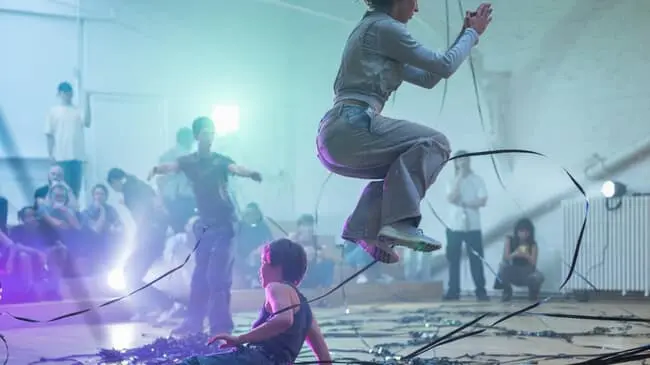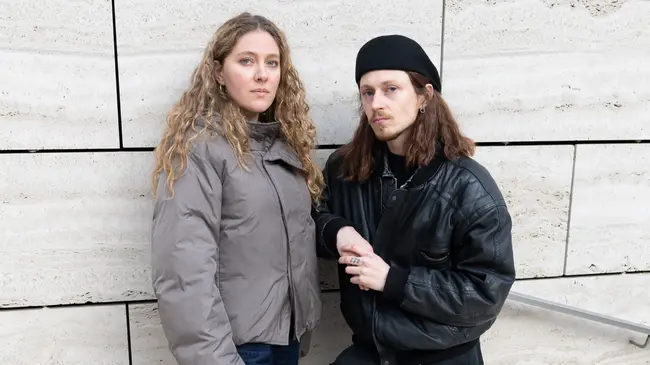I am always trying to depict something eternal

Deliberately dispersed among the 15th to 18th-century works of Rogier van der Weyden, Dirk Bouts, Pieter Bruegel the Elder, Antoon van Dyck, and Simon Vouet in KMSK’s Old Masters Museum, Fabrice Samyn’s concentrated additions take visitors on a sinuous trail through these historical artworks. We followed the bends of Samyn’s work, zooming into the eye of an omnipotent stag in one room, then positioning ourselves in the reflection of the time in the next. Finally, we sat down with New Master Flor Maesen to discuss this experience, the eternal, and mythologies.
What were your first impressions of the show?
You can see that Fabrice studies somewhat obsessively and tries to make a contemporary dialogue with aspects of the collection. This sometimes works, in the sense that his interventions make us look more sharply at certain things. But this is also a risk because it makes it difficult for the work to stand on its own, and it might stay no more than a comment on the historical works
Why do you think he chose to take that risk?
You can see in all the texts about his work that he tries to tell something about the eternal.
If I were to just see the work, I might not immediately say that this is the case, but in the current context, it seems that he tries to depict life after death or the eternal in comparison to the actual life that is lived. It seems to display this dream of the eternal, or possible eternal realities. I don't know exactly where he wants to go with it.
I am always trying to depict something eternal, something that cannot be placed in time
Is this something that you also consider in your own work?
I think that similarly to Fabrice, I am always trying to depict something eternal, something that cannot be placed in time. For example, in my work, you will never see a car, contemporary clothing or even recognizable landscapes. My work has always been about the human condition, our place in the eternal, and existential questions, translated into various images. It's nice to see this work because it shows that there can be a great difference between the artist’s ideas and their depictions. In Fabrice’s case, his work is not so easily read or felt in its totality without the text.
Fabrice ties his work to these historically and religiously significant images, do you do the same in your practice?
I am trying to get a clearer idea of what artwork is and has been throughout the past. I want to understand what this means for humanity, and what it means to see this work of art depicting this story. This myth of Christ that we see here, for example, has been around for such a long time. But it's not just a myth, there is a reason why it became so strong, and why people have become so violent in defending it as the truth. Perhaps the Jesus myth is a culmination of our mythological storytelling, a long-standing tradition, to teach things about the human condition and the mysteries of life. It might be a culmination of the most powerful and symbolic elements. This story then became so real and so strong that some people began to take it as literal truth. I guess it was impossible in the last hundreds of years for most people to see through it because they didn't have the resources to do so.
Fabrice Samyn worked uniquely with the space he was given, how do you take space into account in your own work?
Since I was young, everything I made had to be a world by itself. I've never really made a series. When an image is made in a fascinating way, it can be a life by itself, it has its own space, its own time, and its own tempo, which I really love. I also experimented a bit with working in the public space and being in direct contact with other humans, making smaller objects, and even co-creating.
Fabrice’s work functioned as an eye-opener to a deeper understanding of this painting
Did any pieces stand out to you?
I liked the works on the wall in the beginning because they were simple natural elements that had an interesting shapes. At first, I thought there were small lines on it, but it was little balls of sap glistening on the wood. I really liked that direction.
I also like that the Color of Time was related to the painting from Rogier Van Der Weyden next to it. This piece zoomed in on the colours of the early morning when the sun is about to come up, as some sort of reset for Jesus who died for the sins of humanity. Fabrice tried to capture the colours of this moment in this glass bulb. There is a lot to say about the coming of the day, the night literally changes the way people behave or psychologically experience the world.
We spent a lot of time with Lucas Cranach’s Studio, tell me about that one.
I thought the eye of the stag in this work was very interesting. Fabrice made a little painting of the eye of a deer in a famous painting of Adam and Eve by Lucas Cranach, as if it was photographed with a blurry camera, and then painted. In the original painting, Eve is about to eat the apple, and in the eye of the deer is a reflection of a window, the window of Lucas Cranach’s studio. The more we looked at the painting and thought about it, we came to the conclusion that the deer was a personification of the artist, who is watching a mythological moment that might not have ever existed, but if it is in our collective memory, then it sort-of exists. The artist creates, and thus witnesses, this event in a human size, which must be extremely intimate. Living with this biblical story must have been very intense. So maybe he wanted to show this relationship and insert himself in the image. It also feels like the deer is the only thing that is really alive in the image. So Fabrice’s work functioned as an eye-opener to a deeper understanding of this painting and helped to connect it to our own human reality.
Different Class works with the interest of their community at heart.
Our work’s purpose is to foster a solid network for independent artists, those who love them, and those who want to support them. Become a member to contribute to the local Belgian art scene.





